Type-II GaSe/MoS2 van der Waals Heterojunction for High-Performance Flexible Photodetector
Abstract
:1. Introduction
2. Materials and Methods
2.1. Preparation of GaSe/MoS2 vdW Heterojunctions
2.2. Fabrication of Flexible Photodetectors
2.3. Characterization of Samples and Measurement of Photodetectors
3. Results and Discussion
3.1. Characterization of Individual GaSe, MoS2 and Their Heterostructure
3.2. Fabrication Process of Photodetectors
3.3. Photoresponse of the GaSe, MoS2 and Heterostructure Photodetector
3.4. Flexible GaSe/MoS2 Heterojunction Photodetector
4. Conclusions
Supplementary Materials
Author Contributions
Funding
Data Availability Statement
Conflicts of Interest
References
- Liu, J.; Hu, D.; Ni, M.; Zou, Y.; Gu, Y.; Han, Z.; Li, J.; He, Y.; Zhang, Z.; Xu, X. Monolithic RGB-NIR Perovskite Photodetector for Fused Multispectral Sensing and Imaging. J. Phys. Chem. Lett. 2022, 13, 3659–3666. [Google Scholar] [CrossRef] [PubMed]
- Liu, Y.; Liu, C.; Shen, K.; Sun, P.; Li, W.; Zhao, C.; Ji, Z.; Mai, Y.; Mai, W. Underwater Multispectral Computational Imaging Based on a Broadband Water-Resistant Sb2Se3 Heterojunction Photodetector. ACS Nano 2022, 16, 5820–5829. [Google Scholar] [CrossRef]
- Wu, W.; Zhou, M.; Li, D.; Li, S.; Yang, Z.; Huo, Z.; Wu, Y.; Tan, Y.; Han, X.; Pan, C.; et al. A novel visible light sensing and recording system enabled by integration of photodetector and electrochromic devices. Nanoscale 2021, 13, 9177–9184. [Google Scholar] [CrossRef]
- Wu, W.; Han, X.; Li, J.; Wang, X.; Zhang, Y.; Huo, Z.; Chen, Q.; Sun, X.; Xu, Z.; Tan, Y.; et al. Ultrathin and Conformable Lead Halide Perovskite Photodetector Arrays for Potential Application in Retina-Like Vision Sensing. Adv. Mater. 2021, 33, 2006006. [Google Scholar] [CrossRef] [PubMed]
- Zhang, J.; Jiang, M.; Bian, L.; Wu, D.; Qin, H.; Yang, W.; Zhao, Y.; Wu, Y.; Zhou, M.; Lu, S. A Self-Powered Transparent Photodetector Based on Detached Vertical (In,Ga)N Nanowires with 360 degrees Omnidirectional Detection for Underwater Wireless Optical Communication. Nanomaterials 2021, 11, 2959. [Google Scholar] [CrossRef] [PubMed]
- Lu, Y.; Wang, Y.; Xu, C.; Xie, C.; Li, W.; Ding, J.; Zhou, W.; Qin, Z.; Shen, X.; Luo, L.B. Construction of PtSe2/Ge heterostructure-based short-wavelength infrared photodetector array for image sensing and optical communication applications. Nanoscale 2021, 13, 7606–7612. [Google Scholar] [CrossRef]
- Liu, S.; Zhang, X.D.; Gu, X.; Ming, D. Photodetectors based on two dimensional materials for biomedical application. Biosens. Bioelectron. 2019, 143, 111617. [Google Scholar] [CrossRef]
- Xin, Y.; Wang, X.; Chen, Z.; Weller, D.; Wang, Y.; Shi, L.; Ma, X.; Ding, C.; Li, W.; Guo, S.; et al. Polarization-Sensitive Self-Powered Type-II GeSe/MoS2 van der Waals Heterojunction Photodetector. ACS Appl. Mater. Interfaces 2020, 12, 15406–15413. [Google Scholar] [CrossRef]
- Varghese, A.; Saha, D.; Thakar, K.; Jindal, V.; Ghosh, S.; Medhekar, N.V.; Ghosh, S.; Lodha, S. Near-Direct Bandgap WSe2/ReS2 Type-II pn Heterojunction for Enhanced Ultrafast Photodetection and High-Performance Photovoltaics. Nano Lett. 2020, 20, 1707–1717. [Google Scholar] [CrossRef]
- Jia, C.; Huang, X.; Wu, D.; Tian, Y.; Guo, J.; Zhao, Z.; Shi, Z.; Tian, Y.; Jie, J.; Li, X. Ultrasensitive self-driven broadband photodetector based on a 2D-WS2/GaAs type-II Zener heterojunction. Nanoscale 2020, 12, 4435–4444. [Google Scholar] [CrossRef]
- Duan, J.; Chava, P.; Ghorbani-Asl, M.; Lu, Y.; Erb, D.; Hu, L.; Echresh, A.; Rebohle, L.; Erbe, A.; Krasheninnikov, A.V.; et al. Self-Driven Broadband Photodetectors Based on MoSe2/FePS3 van der Waals n-p Type-II Heterostructures. ACS Appl. Mater. Interfaces 2022, 14, 11927–11936. [Google Scholar] [CrossRef]
- Wang, H.; Li, Z.; Li, D.; Chen, P.; Pi, L.; Zhou, X.; Zhai, T. Van der Waals Integration Based on Two-Dimensional Materials for High-Performance Infrared Photodetectors. Adv. Funct. Mater. 2021, 31, 2103106. [Google Scholar] [CrossRef]
- Tan, C.; Cao, X.; Wu, X.J.; He, Q.; Yang, J.; Zhang, X.; Chen, J.; Zhao, W.; Han, S.; Nam, G.H.; et al. Recent Advances in Ultrathin Two-Dimensional Nanomaterials. Chem. Rev. 2017, 117, 6225–6331. [Google Scholar] [CrossRef] [PubMed]
- Long, R.; Prezhdo, O.V. Quantum Coherence Facilitates Efficient Charge Separation at a MoS2/MoSe2 van der Waals Junction. Nano Lett. 2016, 16, 1996–2003. [Google Scholar] [CrossRef] [PubMed]
- Pasupuleti, K.S.; Reddeppa, M.; Park, B.-G.; Oh, J.-E.; Kim, S.-G.; Kim, M.-D. Efficient Charge Separation in Polypyrrole/GaN-Nanorod-Based Hybrid Heterojunctions for High-Performance Self-Powered UV Photodetection. Phys. Status Solidi (RRL) Rapid Res. Lett. 2021, 15, 2000518. [Google Scholar] [CrossRef]
- Hong, X.; Kim, J.; Shi, S.F.; Zhang, Y.; Jin, C.; Sun, Y.; Tongay, S.; Wu, J.; Zhang, Y.; Wang, F. Ultrafast charge transfer in atomically thin MoS2/WS2 heterostructures. Nat. Nanotechnol. 2014, 9, 682–686. [Google Scholar] [CrossRef]
- Rybkovskiy, D.V.; Arutyunyan, N.R.; Orekhov, A.S.; Gromchenko, I.A.; Vorobiev, I.V.; Osadchy, A.V.; Salaev, E.Y.; Baykara, T.K.; Allakhverdiev, K.R.; Obraztsova, E.D. Size-induced effects in gallium selenide electronic structure: The influence of interlayer interactions. Phys. Rev. B 2011, 84, 085314. [Google Scholar] [CrossRef]
- Hu, P.; Wen, Z.; Wang, L.; Tan, P.; Xiao, K. Synthesis of Few-Layer GaSe Nanosheets for High Performance Photodetectors. ACS Nano 2012, 6, 5988–5994. [Google Scholar] [CrossRef]
- Huang, H.; Wang, P.; Gao, Y.; Wang, X.; Lin, T.; Wang, J.; Liao, L.; Sun, J.; Meng, X.; Huang, Z.; et al. Highly sensitive phototransistor based on GaSe nanosheets. Appl. Phys. Lett. 2015, 107, 143112. [Google Scholar] [CrossRef]
- Allakhverdiev, K.R.; Yetis, M.Ö.; Özbek, S.; Baykara, T.K.; Salaev, E.Y. Effective nonlinear GaSe crystal. Optical properties and applications. Laser Phys. 2009, 19, 1092–1104. [Google Scholar] [CrossRef]
- Tang, Y.; Xie, W.; Mandal, K.C.; McGuire, J.A.; Lai, C.W. Optical and spin polarization dynamics in GaSe nanoslabs. Phys. Rev. B 2015, 91, 195429. [Google Scholar] [CrossRef]
- Kuc, A.; Zibouche, N.; Heine, T. Influence of quantum confinement on the electronic structure of the transition metal sulfide TS2. Phys. Rev. B 2011, 83, 245213. [Google Scholar] [CrossRef]
- Radisavljevic, B.; Radenovic, A.; Brivio, J.; Giacometti, V.; Kis, A. Single-layer MoS2 transistors. Nat. Nanotechnol. 2011, 6, 147–150. [Google Scholar] [CrossRef] [PubMed]
- Chen, H.; Wen, X.; Zhang, J.; Wu, T.; Gong, Y.; Zhang, X.; Yuan, J.; Yi, C.; Lou, J.; Ajayan, P.M.; et al. Ultrafast formation of interlayer hot excitons in atomically thin MoS2/WS2 heterostructures. Nat. Commun. 2016, 7, 12512. [Google Scholar] [CrossRef] [PubMed]
- Tang, W.; Liu, C.; Wang, L.; Chen, X.; Luo, M.; Guo, W.; Wang, S.-W.; Lu, W. MoS2 nanosheet photodetectors with ultrafast response. Appl. Phys. Lett. 2017, 111, 153502. [Google Scholar] [CrossRef]
- Xie, Y.; Zhang, B.; Wang, S.; Wang, D.; Wang, A.; Wang, Z.; Yu, H.; Zhang, H.; Chen, Y.; Zhao, M.; et al. Ultrabroadband MoS2 Photodetector with Spectral Response from 445 to 2717 nm. Adv. Mater. 2017, 29, 1605972. [Google Scholar] [CrossRef]
- Zhou, N.; Wang, R.; Zhou, X.; Song, H.; Xiong, X.; Ding, Y.; Lu, J.; Gan, L.; Zhai, T. P-GaSe/N-MoS2 Vertical Heterostructures Synthesized by van der Waals Epitaxy for Photoresponse Modulation. Small 2018, 14, 1702731. [Google Scholar] [CrossRef]
- Islam, A.; Lee, J.; Feng, P.X.-L. Atomic Layer GaSe/MoS2 van der Waals Heterostructure Photodiodes with Low Noise and Large Dynamic Range. ACS Photonics 2018, 5, 2693–2700. [Google Scholar] [CrossRef]
- He, Z.; Guo, J.; Li, S.; Lei, Z.; Lin, L.; Ke, Y.; Jie, W.; Gong, T.; Lin, Y.; Cheng, T.; et al. GaSe/MoS2 Heterostructure with Ohmic-Contact Electrodes for Fast, Broadband Photoresponse, and Self-Driven Photodetectors. Adv. Mater. Interfaces 2020, 7, 1901848. [Google Scholar] [CrossRef]
- Zou, Z.; Liang, J.; Zhang, X.; Ma, C.; Xu, P.; Yang, X.; Zeng, Z.; Sun, X.; Zhu, C.; Liang, D.; et al. Liquid-Metal-Assisted Growth of Vertical GaSe/MoS2 p-n Heterojunctions for Sensitive Self-Driven Photodetectors. ACS Nano 2021, 15, 10039–10047. [Google Scholar] [CrossRef]
- Wu, X.; Guo, W.; Li, M.; Xiao, C.; Ou, T.; Qiu, Z.; Wang, Y. Influence of the Device Structure on the Electrical and Photodetector Properties of n-MoS2/p-GaSe Heterojunction Optoelectronic Devices. ACS Appl. Nano Mater. 2023, 6, 11327–11333. [Google Scholar] [CrossRef]
- Dong, T.; Simões, J.; Yang, Z. Flexible Photodetector Based on 2D Materials: Processing, Architectures, and Applications. Adv. Mater. Interfaces 2020, 7, 1901657. [Google Scholar] [CrossRef]
- Choi, J.M.; Jang, H.Y.; Kim, A.R.; Kwon, J.D.; Cho, B.; Park, M.H.; Kim, Y. Ultra-flexible and rollable 2D-MoS2/Si heterojunction-based near-infrared photodetector via direct synthesis. Nanoscale 2021, 13, 672–680. [Google Scholar] [CrossRef] [PubMed]
- Luo, S.; Wu, Z.; Zhao, J.; Luo, Z.; Qiu, Q.; Li, Z.; Wu, H.; Xing, G.; Wu, C. ZIF-67 Derivative Decorated MXene for a Highly Integrated Flexible Self-Powered Photodetector. ACS Appl. Mater. Interfaces 2022, 14, 19725–19735. [Google Scholar] [CrossRef]
- Kim, T.; Jeong, S.; Kim, K.H.; Shim, H.; Kim, D.; Kim, H.J. Engineered Surface Halide Defects by Two-Dimensional Perovskite Passivation for Deformable Intelligent Photodetectors. ACS Appl. Mater. Interfaces 2022, 14, 26004–26013. [Google Scholar] [CrossRef]
- Xue, Y.; Zhang, Y.; Liu, Y.; Liu, H.; Song, J.; Sophia, J.; Liu, J.; Xu, Z.; Xu, Q.; Wang, Z.; et al. Scalable Production of a Few-Layer MoS2/WS2 Vertical Heterojunction Array and Its Application for Photodetectors. ACS Nano 2016, 10, 573–580. [Google Scholar] [CrossRef]
- Wu, Y.; Fuh, H.-R.; Zhang, D.; Coileáin, C.Ó.; Xu, H.; Cho, J.; Choi, M.; Chun, B.S.; Jiang, X.; Abid, M.; et al. Simultaneous large continuous band gap tunability and photoluminescence enhancement in GaSe nanosheets via elastic strain engineering. Nano Energy 2017, 32, 157–164. [Google Scholar] [CrossRef]
- Rahaman, M.; Bejani, M.; Salvan, G.; Lopez-Rivera, S.A.; Pulci, O.; Bechstedt, F.; Zahn, D.R.T. Vibrational properties of GaSe: A layer dependent study from experiments to theory. Semicond. Sci. Tech. 2018, 33, 125008. [Google Scholar] [CrossRef]
- Li, H.; Zhang, Q.; Yap, C.C.R.; Tay, B.K.; Edwin, T.H.T.; Olivier, A.; Baillargeat, D. From Bulk to Monolayer MoS2: Evolution of Raman Scattering. Adv. Funct. Mater. 2012, 22, 1385–1390. [Google Scholar] [CrossRef]
- Jie, W.; Chen, X.; Li, D.; Xie, L.; Hui, Y.Y.; Lau, S.P.; Cui, X.; Hao, J. Layer-dependent nonlinear optical properties and stability of non-centrosymmetric modification in few-layer GaSe sheets. Angew. Chem. Int. Ed. 2015, 54, 1185–1189. [Google Scholar] [CrossRef]
- Kwak, J.Y.; Hwang, J.; Calderon, B.; Alsalman, H.; Munoz, N.; Schutter, B.; Spencer, M.G. Electrical Characteristics of Multilayer MoS2 FET’s with MoS2/Graphene Heterojunction Contacts. Nano Lett. 2014, 14, 4511–4516. [Google Scholar] [CrossRef] [PubMed]
- Kind, H.; Yan, H.; Messer, B.; Law, M.; Yang, P. Nanowire Ultraviolet Photodetectors and Optical Switches. Adv. Mater. 2002, 14, 158–160. [Google Scholar] [CrossRef]
- Shao, D.; Gao, J.; Chow, P.; Sun, H.; Xin, G.; Sharma, P.; Lian, J.; Koratkar, N.A.; Sawyer, S. Organic–Inorganic Heterointerfaces for Ultrasensitive Detection of Ultraviolet Light. Nano Lett. 2015, 15, 3787–3792. [Google Scholar] [CrossRef] [PubMed]
- Xing, X.; Zhang, Q.; Huang, Z.; Lu, Z.; Zhang, J.; Li, H.; Zeng, H.; Zhai, T. Strain Driven Spectral Broadening of Pb Ion Exchanged CdS Nanowires. Small 2016, 12, 874–881. [Google Scholar] [CrossRef] [PubMed]
- Yin, Z.; Li, H.; Li, H.; Jiang, L.; Shi, Y.; Sun, Y.; Lu, G.; Zhang, Q.; Chen, X.; Zhang, H. Single-Layer MoS2 Phototransistors. ACS Nano 2011, 6, 74–80. [Google Scholar] [CrossRef]
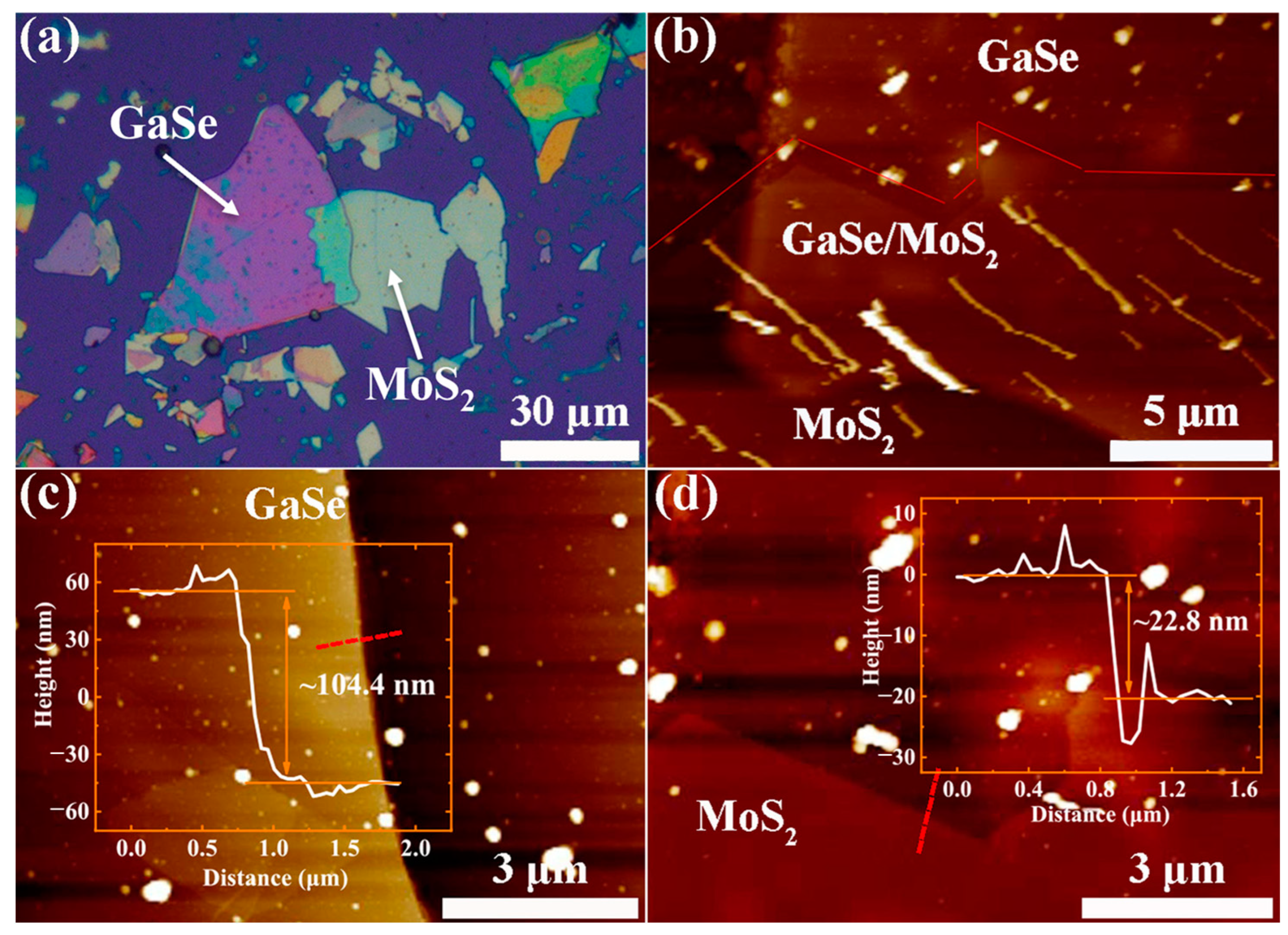

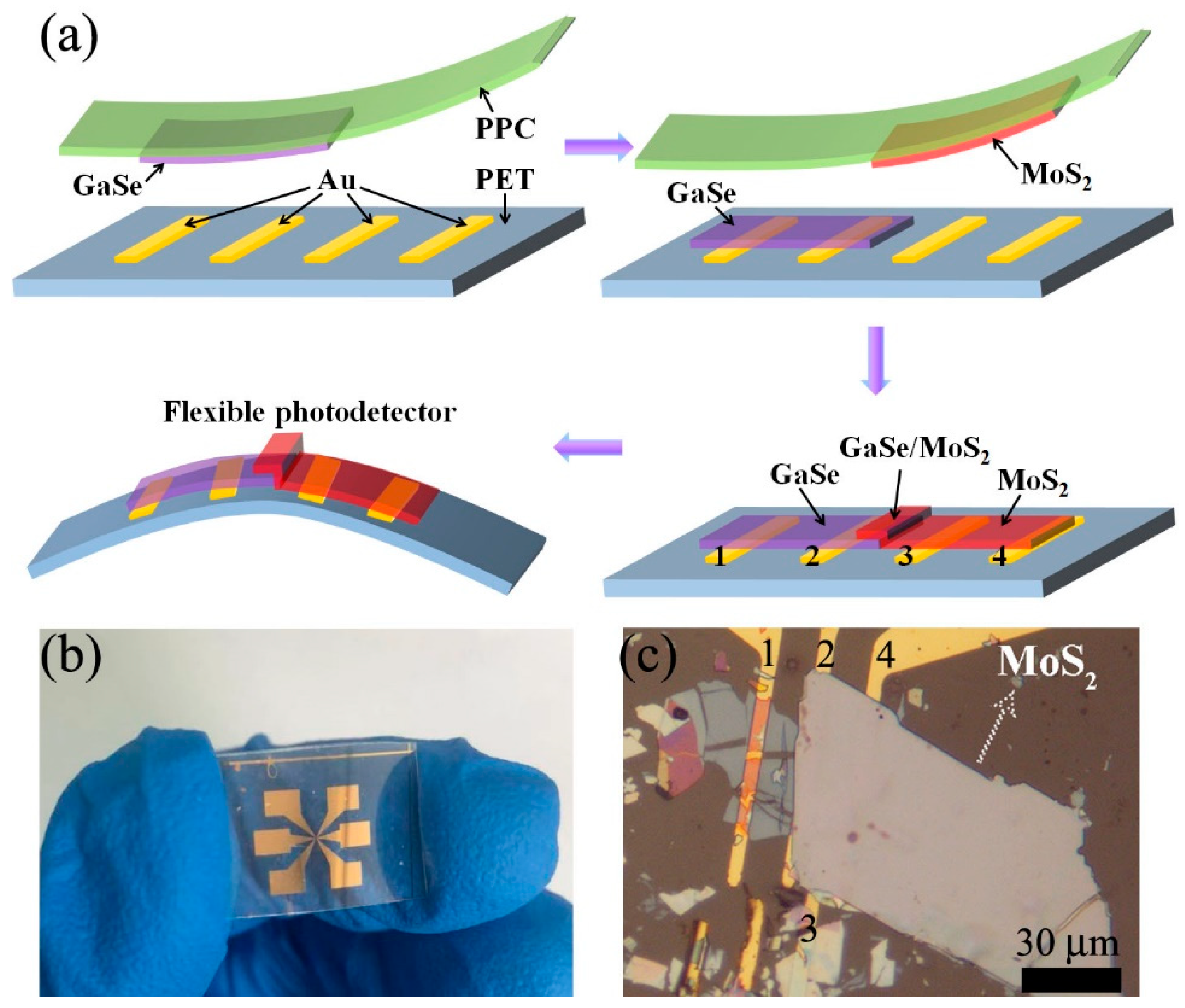
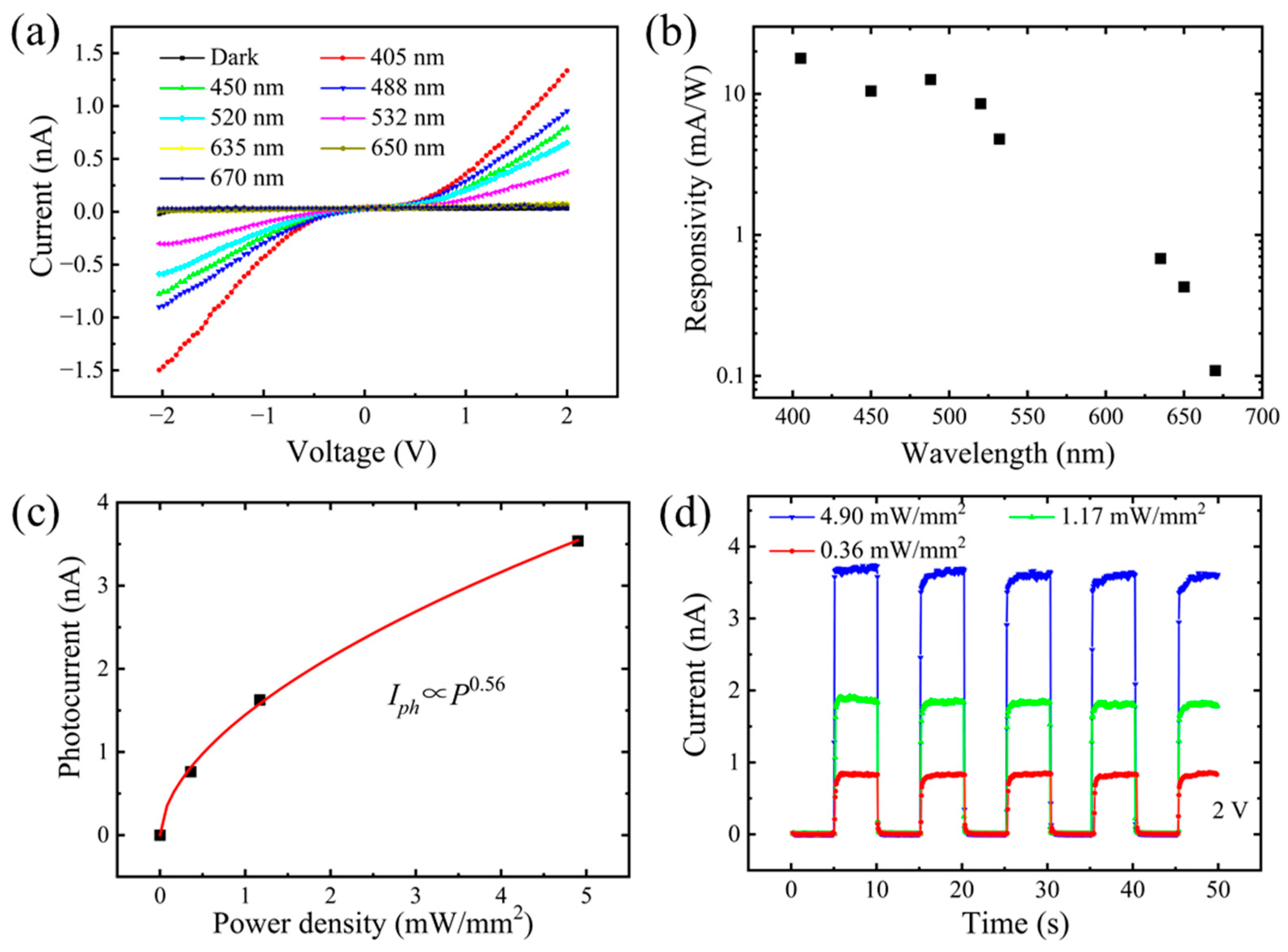


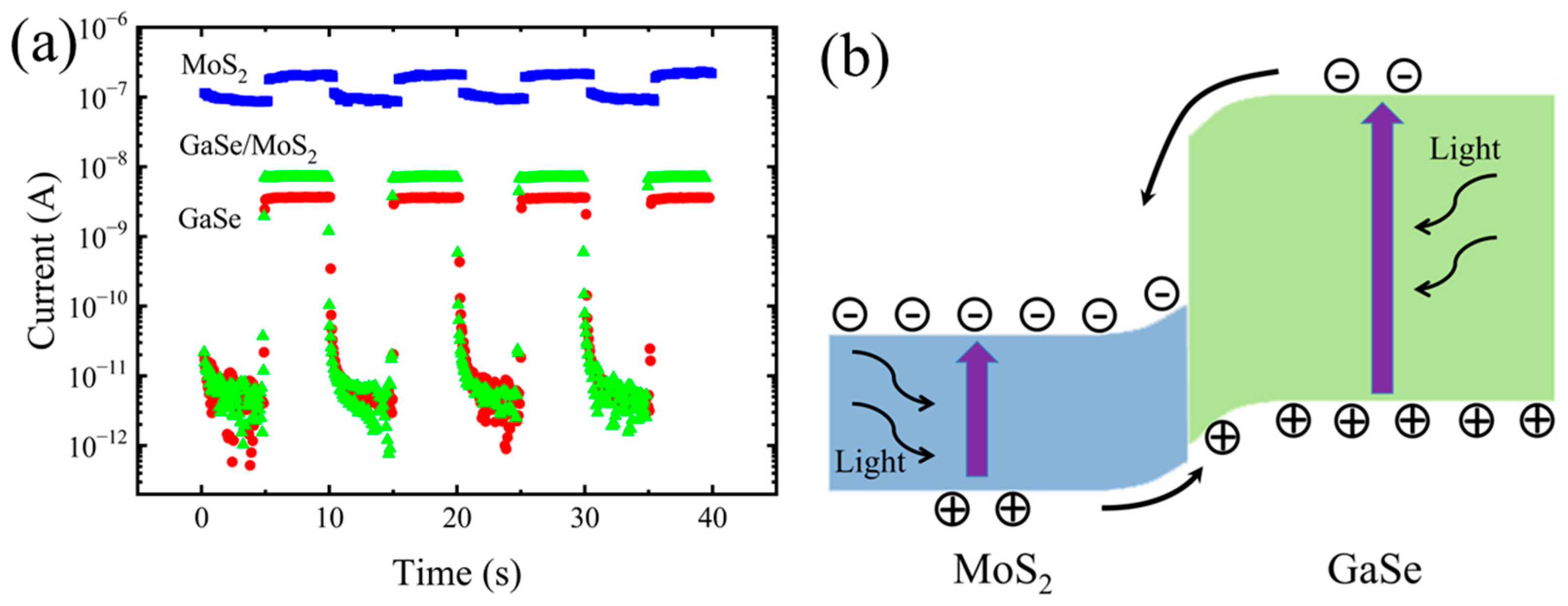
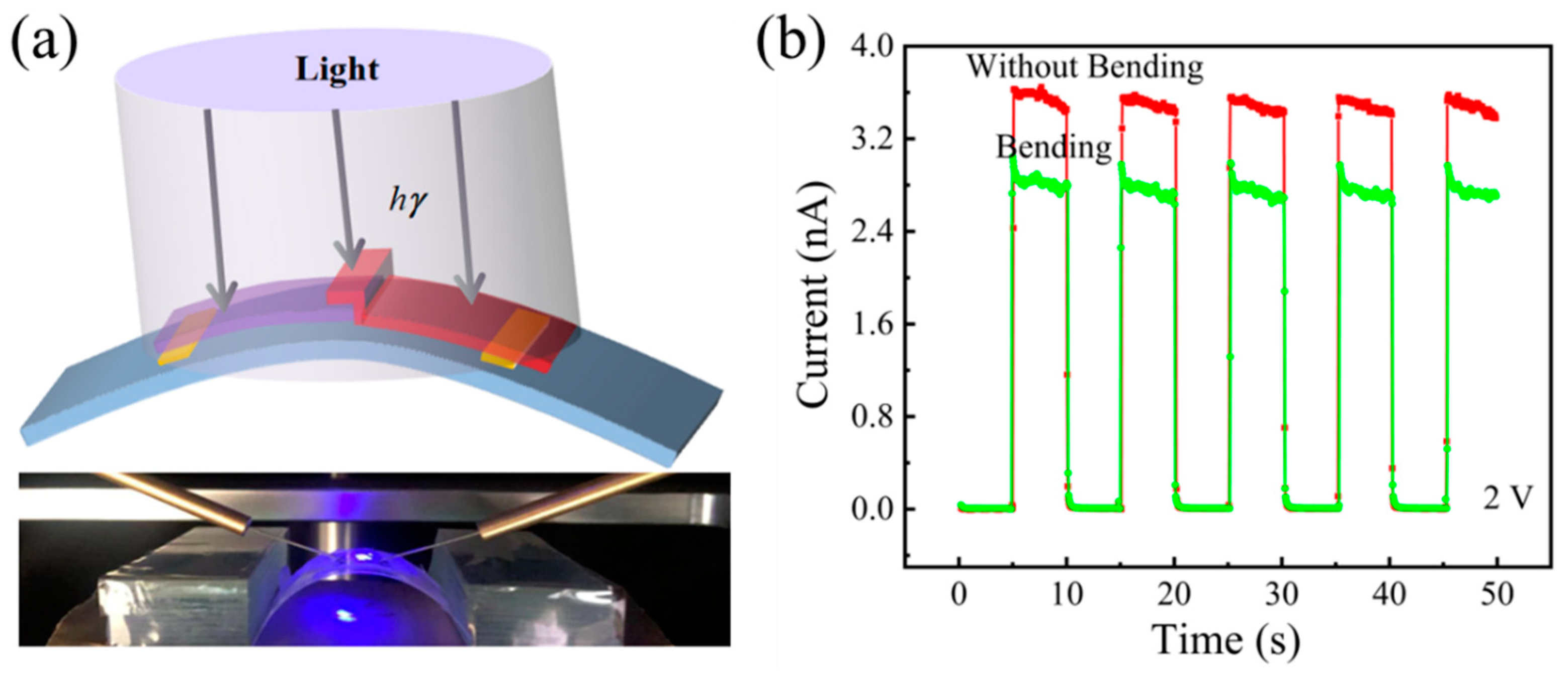
Disclaimer/Publisher’s Note: The statements, opinions and data contained in all publications are solely those of the individual author(s) and contributor(s) and not of MDPI and/or the editor(s). MDPI and/or the editor(s) disclaim responsibility for any injury to people or property resulting from any ideas, methods, instructions or products referred to in the content. |
© 2023 by the authors. Licensee MDPI, Basel, Switzerland. This article is an open access article distributed under the terms and conditions of the Creative Commons Attribution (CC BY) license (https://creativecommons.org/licenses/by/4.0/).
Share and Cite
Wang, S.; Tang, X.; Alim, E.; Sun, X.; Wei, Z.; Tao, H.; Wen, Y.; Wu, S.; Cai, Y.; Wang, Y.; et al. Type-II GaSe/MoS2 van der Waals Heterojunction for High-Performance Flexible Photodetector. Crystals 2023, 13, 1602. https://doi.org/10.3390/cryst13111602
Wang S, Tang X, Alim E, Sun X, Wei Z, Tao H, Wen Y, Wu S, Cai Y, Wang Y, et al. Type-II GaSe/MoS2 van der Waals Heterojunction for High-Performance Flexible Photodetector. Crystals. 2023; 13(11):1602. https://doi.org/10.3390/cryst13111602
Chicago/Turabian StyleWang, Shuai, Xiaoqiu Tang, Ezimetjan Alim, Xingdong Sun, Zheng Wei, Hualong Tao, Yang Wen, Sumei Wu, Yongqing Cai, Yingying Wang, and et al. 2023. "Type-II GaSe/MoS2 van der Waals Heterojunction for High-Performance Flexible Photodetector" Crystals 13, no. 11: 1602. https://doi.org/10.3390/cryst13111602
APA StyleWang, S., Tang, X., Alim, E., Sun, X., Wei, Z., Tao, H., Wen, Y., Wu, S., Cai, Y., Wang, Y., Liang, Y., & Zhang, Z. (2023). Type-II GaSe/MoS2 van der Waals Heterojunction for High-Performance Flexible Photodetector. Crystals, 13(11), 1602. https://doi.org/10.3390/cryst13111602






